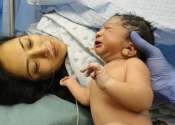Last update:
Medical economics news
Health
New York City's medical specialist advantage may be an illusion
New York City offers nearly every type of medical specialist but provides fewer specialty health care providers per capita than smaller cities, according to a new study that challenges conventional assumptions about urban ...
11 hours ago
0
0
Medical economics
Balancing the promise of health AI with its carbon costs
The health care industry is increasingly relying on artificial intelligence—in responding to patient queries, for example—and a new Cornell study shows how decision-makers can use real-world data to build sustainability ...
12 hours ago
0
0
Researchers call for further improvement of hospital discharge summaries
A new review of existing practice and policy, led by experts at the University of Nottingham, has highlighted the need to improve hospital doctors' understanding of how GPs operate as "expert generalists" as the key to tackling ...
10 hours ago
0
0

Harvard, like all Americans, can't be punished by the government for speaking freely
When the federal government threatened to cancel billions in research funds from Harvard University—as it has also done to other research universities—the message was clear: Institutions that speak or think in ways elected ...
12 hours ago
0
0

A third of licensed GPs in England not working in NHS general practice
Despite rising patient demand and commitments to strengthen primary care, one in three GPs with a license to practice in England are not working in NHS general practice, finds a study published by The BMJ.
7 hours ago
0
0

FDA cracks down on Hims, other telehealth companies over drug ads
Federal health officials are cracking down on telehealth companies' promotion of unapproved versions of prescription drugs, including popular weight loss medications.
12 hours ago
0
0

Calling deaths 'preventable' can obscure barriers to health care access and shift blame to individuals
Each year in the U.S., tens of thousands of deaths are categorized as "preventable"—meaning, in theory, they did not need to happen. A missed cancer screening, a fatal asthma attack or a death from untreated infection might ...
12 hours ago
0
0

Psychogeography makes maps of our emotions—with huge potential for health care services
Have you ever mentally mapped out the streets between your home and your workplace or favorite café, focusing solely on those two places without visualizing what exists in between them? If you have, you will know that, in ...
14 hours ago
0
0

Insurance company repeatedly denied her medical claim, then AI delivered victory
Health insurance giant Anthem wanted $1,800 from Lauren Gonzalves for hospital nursery services after the birth of her son. But it had been two years since the Concord mother gave birth, she had already paid her out-of-pocket ...
15 hours ago
0
0

Actors push for women's health on Capitol Hill
Two things changed Lupita Nyong'o's life in 2014. She won an Academy Award and she was diagnosed with uterine fibroids.
15 hours ago
0
0

How primary care clinics can help curb the opioid epidemic
The U.S. is in the midst of an opioid epidemic; overdose deaths from synthetic opioids such as fentanyl have increased more than 100-fold since 1999. Medications like buprenorphine, methadone and naltrexone can all help treat ...
20 hours ago
0
0

Cuts to U.S. foreign aid could drive millions of new TB cases and deaths, finds new study
U.S. foreign aid cuts could result in over 10 million additional tuberculosis (TB) cases and 2.5 million more deaths in the next years, across 26 countries with high TB burden, found a study by Center for Modeling and Analysis, ...

Patients in least developed countries three times more likely to die after abdominal trauma surgery, study reveals
Mortality after emergency abdominal surgery is more than three times higher in the least developed countries compared to the most developed. Yet among those who undergo surgery, injuries tend to be less severe—raising concerns ...
Sep 16, 2025
0
42

Framework developed for unified approach focuses on important and common clinical conditions
In a new position paper, the American College of Physicians (ACP) identifies core clinical topics of importance to internal medicine physicians, sets a framework for identifying a streamlined set of core performance measures, ...
Sep 16, 2025
0
0

Extended data capture details of two years of earned sick leave laws in 75 largest US cities
Data now available on LawAtlas.org describe details of state, county, and city earned sick leave laws across the 75 largest cities in effect as of July 1, 2022, through June 1, 2024. The data are a longitudinal version of ...
Sep 16, 2025
0
0

Affirmative action critics refuse to back down in fight over medical bias training
Critics of affirmative action have launched a long-shot appeal aimed at stopping California from requiring training on unconscious bias in every continuing medical education class.
Sep 16, 2025
0
0

Eradicating mold would save millions in health care costs: How our homes affect our health
Housing is a key determinant of physical health. Housing conditions can increase or reduce the risk of problems including respiratory illness, heart disease and injury.
Sep 15, 2025
1
16

Over-the-counter sales of overdose reversal drug naloxone decline after initial surge
Sales of the overdose reversal medication naloxone increased after it was made available to the public without a prescription but then dipped quickly in the period following the debut of over-the-counter sales, according ...
Sep 15, 2025
1
0

Psychiatric beds at large for-profit chains increase as those at public hospitals dwindle
Inpatient psychiatric care has dramatically shifted to large for-profit chains, according to new research from Columbia University Mailman School of Public Health and Johns Hopkins Bloomberg School of Public Health. The researchers ...
Sep 15, 2025
0
0

Can smarter marketing help 'make America healthy again?'
Not all products are equally beneficial for everyone. Some are double-edged swords—used appropriately, they can be lifesavers; but used in the wrong hands or the wrong way, there can be significant risks involved.
Sep 15, 2025
0
0

Proposed cuts to NIH funding would have ripple effects on research that could hamper the US for decades
In May 2025, the White House proposed reducing the budget of the National Institutes of Health by roughly 40%—from about US$48 billion to $27 billion. Such a move would return NIH funding to levels last seen in 2007. Since ...
Sep 15, 2025
0
0

About 900,000 Kiwis experience food insecurity. It's a quiet crisis that needs urgent attention
Most New Zealanders are feeling the effects of a seemingly relentless rise in the cost of living—at the supermarket, the gas pump and in their household energy bills. For some, however, this tips over into what scholars ...
Sep 15, 2025
0
0

A call to action ahead of Medicaid work requirements
With just over a year to go until low-income people covered by Medicaid expansion in 40 states must start verifying they're working, or are exempt from work requirements, a University of Michigan health care researcher says ...
Sep 15, 2025
0
0

Harm-reduction vending machines offer free naloxone, pregnancy tests and hygiene kits
In the lobby of the YMCA in Reading, Pennsylvania, stands a row of vending machines—but one machine is different from the rest.
Sep 15, 2025
0
0

Trump's Medicaid cuts were aimed at 'able-bodied adults': Hospitals say kids will be hurt
Republicans insist that President Donald Trump's cuts to Medicaid were aimed at reducing fraud and getting more of its adult beneficiaries into jobs. But the side effects may include less care for sick kids.
Sep 15, 2025
0
0












































